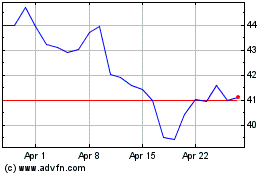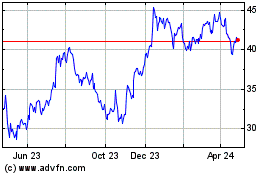U.S. Bank CFO Survey: Corporate Finance Leaders Tighten Belts Amid Uncertainty
April 25 2024 - 6:00AM
Business Wire
- Survey of more than 2,000 U.S. corporate finance leaders
reveals the top two priorities are cost control within finance
function and across the business
- Among top risks, geopolitical tensions rise while inflation
drops significantly
- Just 37% of finance leaders have a positive outlook for the
U.S. economy for the rest of 2024, but nearly 60% are optimistic
about the next three years
U.S. corporate finance leaders have increased focus on cutting
costs to prepare their firms for potential economic and
geopolitical uncertainty, according to the fourth annual U.S. Bank
CFO Insights Report.
The survey of more than 2,000 senior finance leaders nationwide
revealed the top two priorities are cutting costs within the
finance function and across the entire business. In contrast,
driving revenue growth is just the fifth most prevalent priority.
Cutting costs within the finance function has nearly doubled as a
priority since the U.S. Bank CFO Insights Report began in 2021.
Improving risk identification and mitigation also continues to
climb in importance, now the third most common top priority.
For specific top risks, finance leaders continue to identify
areas like talent shortages and pace of technology changes, but
geopolitical tension has jumped six spots from the 10th most cited
risk last year. Meanwhile, high inflation was cited less often this
year as a top risk (25%) compared to last year (38%), although it
remains an elevated risk for some industries, like Telecom and
Media (42%).
“The CFO’s job has always been a challenge. But today they face
higher inflation and interest rates, political uncertainty in the
U.S. and abroad, a difficult-to-forecast short-term economy and
incredible pressure to make the right technology investments their
firms will need to compete,” said Stephen Philipson, head of Global
Markets and Specialized Finance at U.S. Bank. “This year’s survey
showcased how finance leaders are working through this set of
circumstances by focusing on cost cuts and risk management without
neglecting their investment priorities.”
Key survey findings:
Economic outlook vs. business prospects
- 33% of finance leaders hold a negative outlook for the economy
for the rest of 2024. However, the long-term forecast is more
positive, with only 15% maintaining a negative outlook for the U.S.
economy over the next three years.
- Despite the challenging operating environment, 45% of finance
leaders remain optimistic about their business’s financial outlook
over the next 12 months. This number jumps to 61% when they look to
the next three years. For instance, in the automotive industry,
only 37% are positive about the next 12 months, but 63% are
optimistic over the next three years.
Top risks
- Talent shortages continue as the leading risk (41%), marking
the third consecutive year at the top, closely followed by the
challenges related to the pace of technology change/digital
disruption (38%). Industrial Products/Manufacturing (47%),
Hospitality and Leisure (46%) and Technology (46%) finance leaders
were most likely to list talent shortages as a top risk.
- Geopolitical tension and war have jumped to become the
fourth-most cited top risk (26%), climbing from 10th place last
year.
- Inflation comes in fifth place (25%) as a top risk. It has
decreased in urgency for finance leaders from last year’s 38%.
Finance leaders in Telecom and Media (42%) and Consumer and Retail
(36%) were most likely to list inflation as a top risk.
- Nearly four-in-ten of finance leaders (39%) said they’re not
confident about their ability to manage and mitigate new
risks.
Artificial Intelligence (AI) and areas for
efficiencies
- Finance leaders are prioritizing investments in technology
(47%) over layoffs (21%) as the primary solution for cutting costs
in the next 12 months. Comparatively, in 2021 layoffs were at
40%.
- After data analytics (52%), AI is the second-highest priority
for investment in the finance function (51%) and is most
prioritized by finance leaders in Insurance, Oil and Gas and Life
Sciences/Pharmaceutical sectors.
- Uses for AI in the finance function are primarily focused on
tackling risk (42%), identifying fraud (41%) and automating
processes (37%).
- While cost cuts are top of mind, this year’s survey found
finance leaders are more confident about balancing growth
initiatives and cost cutting. 50% said they struggle to balance the
need to cut costs with the need to invest in the future, down from
56% last year.
View the full 2024 U.S. Bank CFO Insights Report.
About the research
The results of this research are based on a survey conducted in
January and February 2024 of 2,030 senior finance leaders who work
in U.S. businesses across multiple sectors. Half of the survey
participants are company, regional or divisional CFOs. The
remainder are senior managers within the finance function. Every
surveyed finance leader works for a business that generates at
least $100 million in annual revenue, and 30% work for a business
that generates at least $2 billion.
About U.S. Bancorp
U.S. Bancorp, with more than 70,000 employees and $684 billion
in assets as of March 31, 2024, is the parent company of U.S. Bank
National Association. Headquartered in Minneapolis, the company
serves millions of customers locally, nationally and globally
through a diversified mix of businesses including consumer banking,
business banking, commercial banking, institutional banking,
payments and wealth management. U.S. Bancorp has been recognized
for its approach to digital innovation, community partnerships and
customer service, including being named one of the 2024 World’s
Most Ethical Companies and Fortune’s most admired superregional
bank. Learn more at usbank.com/about.
View source
version on businesswire.com: https://www.businesswire.com/news/home/20240425962462/en/
Todd Deutsch, U.S. Bank Public Affairs & Communications
todd.deutsch@usbank.com | 612.303.4148
US Bancorp (NYSE:USB)
Historical Stock Chart
From Oct 2024 to Nov 2024

US Bancorp (NYSE:USB)
Historical Stock Chart
From Nov 2023 to Nov 2024
